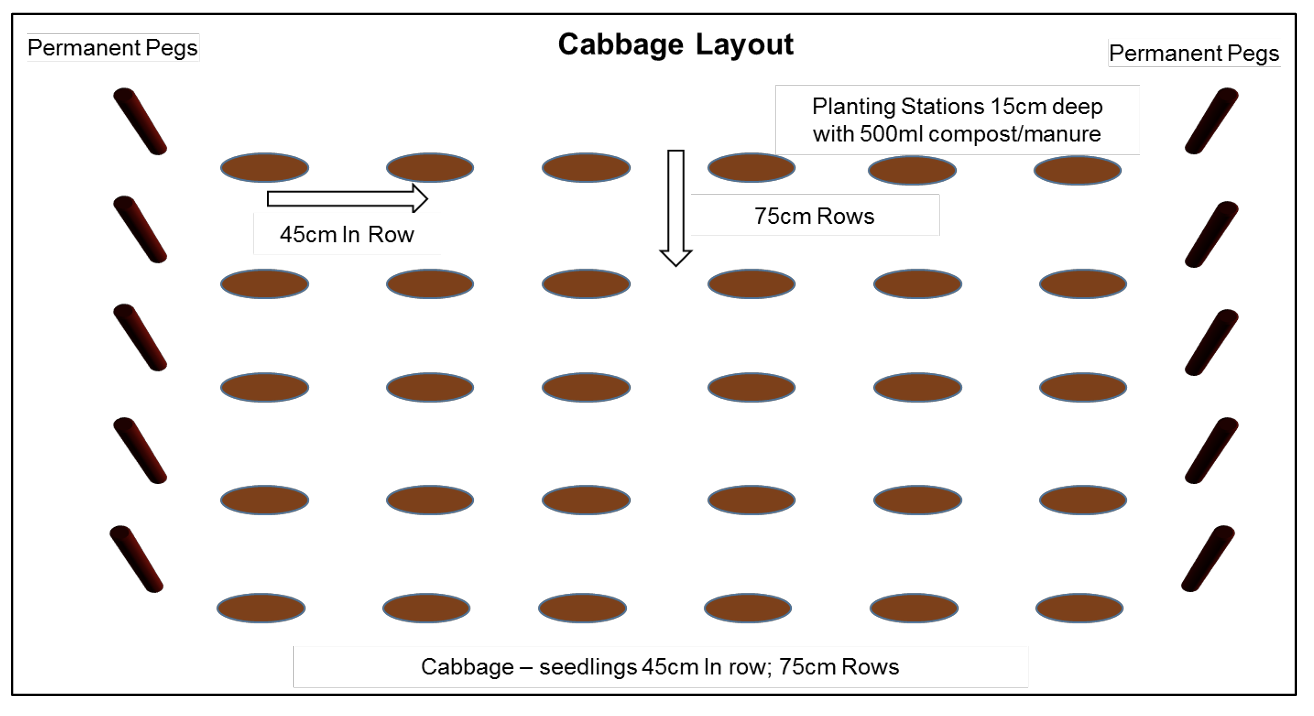6.2.2 Cabbage, Cauliflower and Broccoli – Compost/Manure Technique
The Brassica family are very popular leafy vegetables and are all high in Vitamin C and K. Cabbages are by far one of the most popular vegetables worldwide with double the nutritional value compared to Broccoli and Cauliflower. However the Brassicas all need good management, fertile soils, high volumes of inputs and good pest control and should therefore be avoided until good experience has been gained with other crops.
They are best suited to relatively cool and humid climates with optimal growing temperatures of 15-24°C, but with a range limit of 0-30°C showing their preference for cold rather than hot growing conditions. Certain cultivars can even withstand frost.
Layout
It is recommended to have medium sized, rather than large heads, with 45cm between plants and 75cm between rows. If you prefer very large heads then space your seedlings at 60 by 75cm instead.
Placing Measuring Rope
Place a 45cm measuring rope from one 75cm permanent peg to its adjoining 75cm permanent peg on the opposite side. Make sure the rope is taut and straight by lifting and dropping it.
Remove God’s Blanket
Move God’s Blanket 30cm downslope from each planting station to expose the soil.
Soil Fracturing
Give your cabbages a good chance of success by fracturing each 75cm line to 30cm deep.
Digging Planting Stations
The wide plant spacing make them best suited for inputs placed directly into planting stations rather than surface composting. Dig a planting station 15cm deep at each 45cm interval, moving the soil downslope of the measuring rope, taking care to neatly heap the soil for reuse later. Planting stations should be 12cm wide, 15cm long and 15cm deep. Repeat the planting stations every 75cm row.
Correcting Acidic Soils
To correct acidic soils and allow for readily available plant nutrients apply 1 tablespoon of woodash/bonemeal or 1 teaspoon of lime, in each planting station.
Compost/Manure
It is preferable to apply 500ml of compost or alternatively manure, in each planting station. Take soil from the downslope heap and cover all the inputs until the soil surface is level again. Replace the 2.5cm thick blanket on top of the planting stations.
Planting Seedlings
Once seedlings are at about 10-12cm tall they are ready for transplanting. Twist the dibble stick through the blanket and press it into the centre of each planting station, to the required depth. You must ensure the seedling roots are not bent into a J shape which will adversely affect the plants growth, so make sure the dibble stick hole depth is sufficient but not too deep either. If the hole is too deep, it will cause there to be an air space under the roots which is also not desirable. To ensure you don’t have that, hold the seedling in place and press with the dibble stick or your fingers at an angle, pressing the soil gently around the seedling roots. This ensures the seedling roots have no bend and ensures that there are no airspaces around the root zone.
Top Dressing
These are very high nutrient demand plants so if they shows any signs of yellowing, then top dress with urea or manure tea. When applying diluted manure tea, apply 350ml to each plant base. When applying Urea, push a small hole 3cm deep, three finger widths away, on the upslope side of each plant. Place a teaspoon of Urea in each hole and cover it with soil. Repeat the applications every second week if necessary until 6 weeks old.
Pest Control
Cabbages, Cauliflower and Broccoli are susceptible to many pests and diseases but your first line of defence is keep the plants stress free by having healthy soils, thick mulch cover and an excellent supply of nutrients. Any organic pest management control must focus on prevention rather than cures. It is critical to have a 12 month break in your rotation planning with these crops. Observe your plants regularly and if diseased plants have been identified it is often the best option to simply remove those plants and dispose of them far away from the garden.
Harvest
Be watchful towards the harvest stage to ensure that the crop doesn’t bolt, as then cabbages will split whilst cauliflower and broccoli will go into flower.

